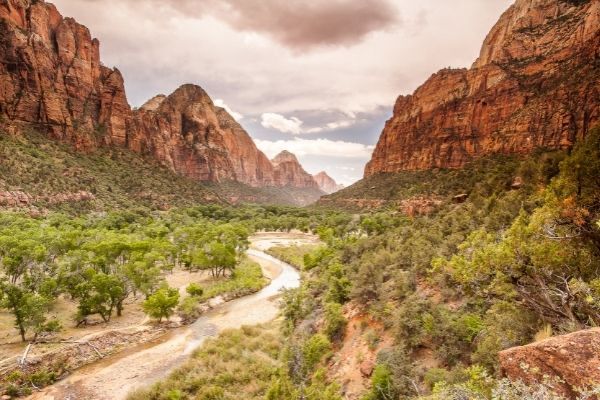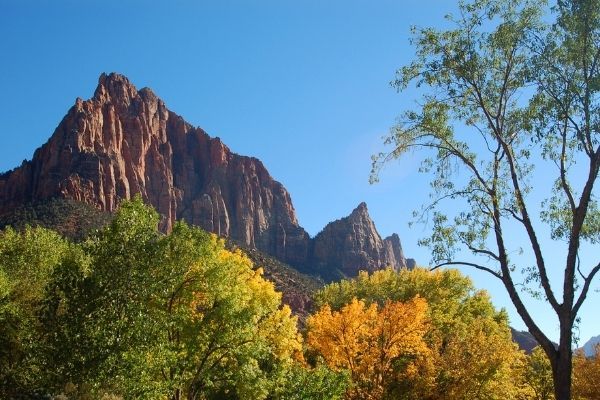After carefully planning your perfect trip to Zion, the last thing you want is to have your plans go awry due to bad weather. While Zion rarely gets rained out (only 68 days of rain a year!), it is very possible that you will encounter a flood watch or warning during your visit. In this case, many canyons and riverside hikes will become unsafe. Additionally, after snowfall, parts of Kolob Terrace and Kolob Canyons may be closed. It is important to have backup plans in place of closures and to respect mother nature’s warnings. No hike is worth risking your safety.
Additionally, Zion’s temperatures vary wildly. From day to night, summer to winter, and lowlands to plateaus, Zion can swing from sweltering to chilling to everything in between. If you are traveling in the summer, anticipate triple-digit days. In the winter, be prepared for snow. No matter the season, be sure to bring plenty of water as well as temperature-appropriate attire for your trip to Zion. Zion is very arid and this low humidity means visitors can quickly become dehydrated. The best way to ensure a great time in Zion is to come prepared!
Zion National Park in Winter
 by MichaelJust from Getty Images
by MichaelJust from Getty Images
Winter is by far the least popular season to visit Zion. But for those looking for a sense of peace and isolation, there really is no better time to visit. Zion still has plenty of gorgeous scenery to offer its wintertime visitors. In fact, there’s nothing quite like waking up to a snow-dusted canyon or driving up to see the frosted evergreens high on the mountain. Just be sure to come equipped with some good snow boots and a heavy jacket, because things can start to get pretty chilly around mid-December. Expect temperatures to reach the mid-fifties in the day and drop to around 30 degrees at night.
For visitors traveling to Zion in winter, expect some park closings to accompany the icy temperatures. While Zion Canyon will be open throughout the year, higher elevations such as Kolob Terrace and Kolob Canyons may be closed due to snowfall. Additionally, some hikes, such as Angel’s Landing, may be too dangerous to attempt due to icy conditions. Winter months see the most precipitation of any season in Zion, so come equipped to hike through snowy and rainy weather.
There are a few other perks to visiting Zion in the winter as well. Winter is the only season in which travelers can drive their own vehicles through Zion Canyon. That’s right, no shuttle buses during winter! (Aside from Christmas week.) Plus, winter is by far the cheapest season to visit, so it may just save you a bit of stress, as well as a few dollars, to plan your trip to Zion as a winter getaway.
Zion National Park in the Spring
 by CarlosChavezPhotography by Getty Images
by CarlosChavezPhotography by Getty Images
As the winter snows begin to melt, Zion enjoys warm days, cool evenings, and the return of life to the canyon. Daytime temperatures remain warm, climbing from the low 60’s in early spring to high 80’s towards May. Nighttime temperatures tend to stay a bit chilly, falling as low as the 40’s or 50’s. While it might be a bit too cool for trekking through the brisk water of The Narrows, Spring is an excellent time to enjoy some of Zion’s longer and warmer trails, or to take on an extended backpacking trip.
Zion experiences the most precipitation during late winter and early spring. Unfortunately, this means that certain areas, like The Narrows, may occasionally be closed due to snowmelt and rising water levels. The good news is that this precipitation brings to life the park’s ephemeral falls and flowers. Many of Zion’s plants hurry to take advantage of these precious seasonal rains. Flowers like the Desert marigold, Slickrock paintbrush, and Claret cup cactus speckle Zion in beautiful reds and golds.
As far as crowds go, March and April are relatively peaceful, while the month of May gets very crowded. While the weather is fantastic in May, be prepared to rub elbows with tourists, as this is the start of Zion’s peak season.
Zion National Park in Summer
 by Victor Lee from Getty Images
by Victor Lee from Getty Images
In summer, Zion is the hot spot to be. And that’s meant both literally and figuratively. Temperatures can easily soar into the triple digits, and crowds from all over rush in for fun under the desert sun. For many parents with school-age children, this will be their summer vacation, and popular and shorter trails can get pretty crowded with families. This is especially true in June and July. If you really want to visit Zion during the peak summer season, consider visiting in late August. This month sees a slight drop in the number of visitors as well as temperatures. Be aware that summer in Zion is also known as the monsoon season. Be sure to check the forecast regularly for heavy precipitation and flash flood watches.
If you are looking to avoid crowds or paying premium prices, summer in Zion may not be for you. For those looking to hike Zion’s most popular trails expect to practice a lot of patience as you make your way through the crowds.
Not only is this the most crowded time to visit the park, it’s the most expensive. Nearby lodging is at its peak price during this season.
On the upside? Summertime in Zion is a great time to hike through shaded slot canyons, raft down the Virgin River, or visit Zion’s higher elevation attractions. My personal recommendation? Take advantage of a Shaka Guide secret and visit some of the lesser-known, cooler sections of Zion National Park—like Kolob Canyons and Kolob Terrace. Temperatures up at the top of Kolob Terrace can be as much as ten degrees cooler, and most visitors don’t even know about these hidden gems.
Zion National Park in Fall
 by Tigerone from Getty Images
by Tigerone from Getty Images
Ahh, fall in Zion National Park. No matter your travel plans, fall is a wonderful time to visit Zion. As the temperatures begin to cool off and the crowds begin to dissipate, Zion becomes a much more navigable place. September still sees temperatures regularly rise into the 90’s, but the evenings are beginning to grow a bit cooler, sometimes dropping as low as 60 degrees. The beginning of September can still be very crowded, with many families trying to squeeze in a last-minute summer vacation. The end of September starts to see the crowds diminish, and by November, Zion is a place of peace once again. Even in November, Zion is fairly warm during the day, with highs in the mid 60’s. Nighttime in November finally sees some real chills, though, with temperatures sometimes dropping below 40 towards the end of the season.
As the days grow shorter in Zion, the leaves begin to change, and reds, golds, and purples begin to color the park. Higher elevations see fall colors begin to emerge in mid-September, while lower elevations will have to wait another month—until about the middle of October.
Most visitors agree—the best time to visit Zion is in Fall. The weather, the prices, and the crowds are all very reasonable. An added bonus? All park services, including the museums, continue until November, meaning visitors during the fall won’t have to miss a thing. Except for the crowds, that is.
Visiting Zion Around Holidays
This may go without saying, but that extra vacation day that you get for Labor Day? You might want to just save that. Holidays in Zion can get very crowded...and expensive! Basically, everyone has the same idea of traveling to Zion for holidays, and that means that an already-crowded park swells with people on these long weekends. For instance, on the fourth of July in 2019, Zion saw 94,000 visitors over that weekend alone. That’s a lot of people! If you’re very patient, it may still be worth it to visit Zion during the holidays, but expect long lines for shuttle rides and popular hikes.
Seasonal Events
Ranger-led events usually begin around the second week of May and conclude around the second week of October. Youth-centered activities, such as the drop-in programs, stop a little earlier, usually finishing up about the second week of September. After all, this is when most kids are returning to school. Additional park services, such as the Nature Center and Human History Museum, are available until November.
For those of you who will be traveling without children, consider visiting during the last weeks of September or first week of October. This way, you can enjoy the best weather, have fewer crowds, and still have all adult-focused activities available to you.
Planning a trip to Zion National Park truly depends on your budget and interests, but no matter when you visit the park you're bound to have a great time! Ready to start planning a trip? Check out our Zion National Park Tour.